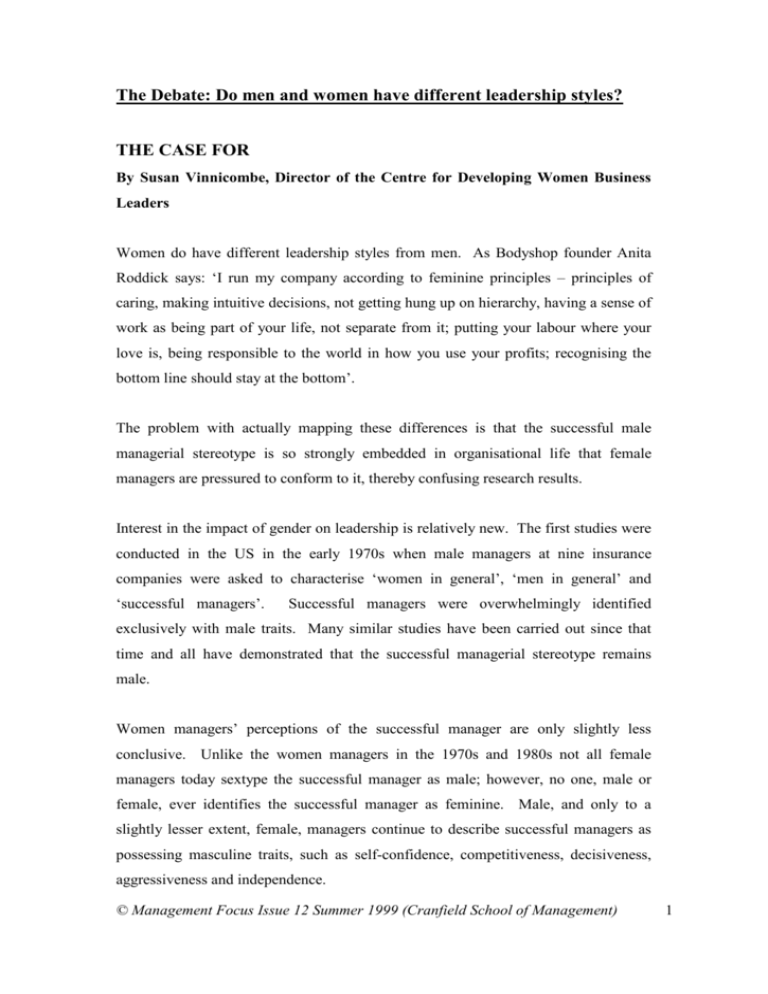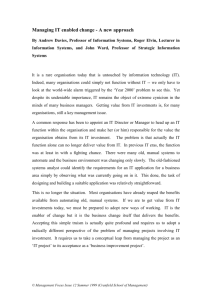The Debate: Do men and women have different leadership styles?
advertisement

The Debate: Do men and women have different leadership styles? THE CASE FOR By Susan Vinnicombe, Director of the Centre for Developing Women Business Leaders Women do have different leadership styles from men. As Bodyshop founder Anita Roddick says: ‘I run my company according to feminine principles – principles of caring, making intuitive decisions, not getting hung up on hierarchy, having a sense of work as being part of your life, not separate from it; putting your labour where your love is, being responsible to the world in how you use your profits; recognising the bottom line should stay at the bottom’. The problem with actually mapping these differences is that the successful male managerial stereotype is so strongly embedded in organisational life that female managers are pressured to conform to it, thereby confusing research results. Interest in the impact of gender on leadership is relatively new. The first studies were conducted in the US in the early 1970s when male managers at nine insurance companies were asked to characterise ‘women in general’, ‘men in general’ and ‘successful managers’. Successful managers were overwhelmingly identified exclusively with male traits. Many similar studies have been carried out since that time and all have demonstrated that the successful managerial stereotype remains male. Women managers’ perceptions of the successful manager are only slightly less conclusive. Unlike the women managers in the 1970s and 1980s not all female managers today sextype the successful manager as male; however, no one, male or female, ever identifies the successful manager as feminine. Male, and only to a slightly lesser extent, female, managers continue to describe successful managers as possessing masculine traits, such as self-confidence, competitiveness, decisiveness, aggressiveness and independence. © Management Focus Issue 12 Summer 1999 (Cranfield School of Management) 1 Positive differences Many managers, both male and female, agree that sex differences in management style do exist. Interestingly both describe women’s differences in positive terms. Yet when researchers ask managers to describe their own management styles they usually find no significant differences between genders. Does this mean no difference exists? No. What these findings reveal is the extent to which individuals characterise themselves in terms of dominant managerial values, in this case masculine behaviour. At the same time managers describe themselves in terms that fit with the prevailing rhetoric of good management practice, now strongly associated with a consultative style and a high level of interpersonal skills. Our research shows that many female managers are uncomfortable with the imposed leadership style and this, in turn, can lead to severe stress. Most senior female managers have no children, believing that the combination of a career and a family is untenable. This is in stark contrast to the majority of senior male managers who have children and a wife at home to support them. Today’s culture of long working hours is exacerbating the problem. Many senior women managers are simply voting with their feet, as Brenda Barnes, president and CEO of Pepsi Cola North America, did to spend more time with her children. This is not an isolated example. A few years ago the management of Deloitte & Touche in the US realised that 90% of the women had gone by partnership time. Style matters Time after time in management development programmes at Cranfield, women managers demonstrate their different working styles. Using the Myers Briggs Type Indicator male managers consistently come out predominantly as Traditionalists (a mix of ‘sensing’ and ‘judgmental’). In contrast, female managers emerge as significantly more ‘intuitive’, combined with either ‘thinking’ as visionaries or ‘feeling’ as catalysts. The natural strength of the visionary is being strategic, while that of the catalyst is fostering higher productivity by personally motivating people. © Management Focus Issue 12 Summer 1999 (Cranfield School of Management) 2 The problem with letting males dominate organisations, as we do, is that leadership style is narrowly defined. Whilst women constitute 41% of the European workforce, they occupy only 10% of mangement positions and represent a mere 1% of executive board members. Yet a recent survey on the most admired boards of Britain’s top 100 companies showed that they have larger boards, more women, more executive directors, their directors have more international experience and are better educated. This is a powerful business argument for greater diversity in leadership. © Management Focus Issue 12 Summer 1999 (Cranfield School of Management) 3 THE CASE AGAINST by Andrew Kakabadse, Professor of International Management Development There is a myth about gender and leadership capabilities. This holds that women are better team players than men; more open and mature in the way they handle sensitive issues; and more conscious of their impact on others and hence better people managers than men. But the myth is false. An international survey by Cranfield comparing top male and female managers in the private and public sector clearly showed that women are no better or worse than men in the practice of management and leadership. It all depends on the man or woman in question, and the organisation for which they work. Factors affecting performance Gender is a red herring. The factors that do significantly influence people’s performance, however, are the length of tenure in the job and organisation, the age of the manager and their attitude. In essence, the longer the manager has been in the job and been held to account for their performance, the more positive, outward-looking and mature they are both in attitude and years; and the more responsive they are to the demands of customers, the better they are as a manager. Countless studies of men and women at work have highlighted the differences they display. The question remains, what is the relevance of such differences to managerial and leadership performance? Gender is but one demographic and, according to our survey, not a significant differentiator of performance. However, context - the culture of the company, the leadership style of the boss and the attitudes in the office – does play a powerful role. Men and women occupying comparable jobs but in different organisations are likely to react differently, not because of differences of personality, or gender, but because of contextual pressures. © Management Focus Issue 12 Summer 1999 (Cranfield School of Management) 4 Special case Women are now regarded as a special case, requiring particular attention in order to be treated on merit, with the recognition that ‘feminine qualities and styles’ neither hinder nor help performance. However, differentiating women from men in order to appoint the most promising candidate, does not mean that, once appointed, similar attention will enhance performance. The peculiarities of the job and the organisation require individuals to fit in and yet contribute. The capacity to balance these paradoxical demands rests with each individual, irrespective of their gender. Both women and men can act as ‘bulls in china shops’, as well as sophisticated managers. Lobby groups have been a powerful force in promoting the cause of women, both at work and socially, particularly in the US. Undoubtedly, these groups have gone a long way to redress the balance. However, one negative effect has emerged, namely that of political correctness. Fear of the backlash that can arise if being critical of any woman, or challenging the current wisdom of how ‘femininity’ can add to the boardroom, maintains the myth of gender differences influencing work related performance. The way forward Today’s economic reality is oversupply. Too many products and services are chasing too few consumers. In order to get that, ‘extra 2%’ which will make the difference, each organisation has to look to itself. Helping people to become more motivated to sell or to provide a higher level of service, requires that staff and management improve dialogue and their internal communications. In effect, internal diversities need to be turned into unique strengths, which give the organisation that extra push. What is the value of sending men and women on separate courses or being given different treatment (unless a special case exists), when aim is to ‘pull together’ in order to survive and prosper? Managing diverse groups to achieve a cohesive philosophy and consistency of performance is what is required of today’s corporate leader. Evidence shows that women and men are as adept, or as bad, as each other at responding to this challenge. © Management Focus Issue 12 Summer 1999 (Cranfield School of Management) 5











